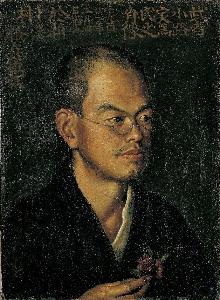Tsubaki Sadao
Tsubaki Sadao
Born: 1896
Death: 1957
Biography:
Tsubaki Sadao was a Japanese oil painter born on August 20, 1896, in Yamagata Prefecture. He studied under Kishida Ryūsei and became friends with Mushanokōji Saneatsu and other members of the Shinjinkai literary group. Tsubaki was a member of the Shunyo-kai art society and participated in their annual exhibitions at the Tokyo Metropolitan Art Museum.
Early Life and Career
Tsubaki Sadao's early life and career were marked by his interest in oil painting. He was influenced by Western art styles, which were introduced to Japan during the Meiji period. Tsubaki's paintings often featured portraits, still lifes, and landscapes, showcasing his unique blend of traditional Japanese techniques with Western influences.
Notable Works
Some of Tsubaki Sadao's notable works include "Portrait of Mushanokoji Saneatsu" (1923), "Still Life with Flowers" (1930), and "Ryusei in the Coffin" (1929). These paintings demonstrate Tsubaki's skill in capturing the essence of his subjects, whether it be a person, an object, or a scene.
- Portraits: Tsubaki Sadao's portraits are characterized by their realism and attention to detail. He often depicted his subjects in formal attire, highlighting their social status and personality.
- Still Lifes: Tsubaki's still lifes showcase his ability to capture the play of light on everyday objects. His use of color and composition creates a sense of depth and texture.
- Landscape: Tsubaki's landscapes often feature Japanese scenery, with an emphasis on the relationship between nature and human presence.
Tsubaki Sadao's work can be found in various museums and collections, including the Tokyo Metropolitan Art Museum and the Yamagata Museum of Art. His paintings are also available for viewing on Wikioo.org, where art lovers can explore his oeuvre and learn more about his life and career.
Legacy
Tsubaki Sadao's legacy as a Japanese oil painter is significant, with his work influencing generations of artists. His unique blend of traditional and Western styles has contributed to the development of modern Japanese art. For more information on Tsubaki Sadao and other Japanese artists, visit Wikioo.org, which features a vast collection of artwork from around the world. Tsubaki Sadao passed away on December 27, 1957, but his art continues to inspire and educate audiences today. His paintings can be found in various museums and collections, including the Yamagata Museum of Art, which is dedicated to preserving and promoting Japanese art.


